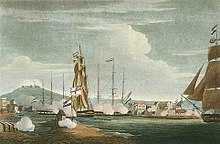Thomas Ball Sulivan
 From Wikipedia - Reading time: 4 min
From Wikipedia - Reading time: 4 min
Thomas Ball Sulivan | |
|---|---|
| Born | 5 January 1781 Cawsand, Cornwall |
| Died | 17 November 1857 (aged 76) Flushing, Cornwall |
| Allegiance | |
| Service | |
| Years of service | 1786–1846 |
| Rank | Rear Admiral |
| Commands | South East Coast of America Station |
| Battles / wars | Napoleonic Wars War of 1812 |
| Awards | Companion of the Order of the Bath |
Rear Admiral Thomas Ball Sulivan CB (5 January 1781 – 17 November 1857) was a Royal Navy officer who became Senior Officer, South East Coast of America Station.
Biography
[edit]
Sulivan was born in Cawsand, Cornwall on 5 January 1780. By 1786, he was recorded on board HMS Triumph in Portsmouth, then under the command of Samuel Hood, 1st Viscount Hood.[1] He served on several different naval ships until 1793, when he was sent to Mediterranean to take part in French Revolutionary Wars, including being part of the crew of HMS Southampton that captured Utile in 1796, and was promoted to lieutenant the following year.[2]
Sulivan took part in the expedition to Ostend to destroy the Bruges Canal in May 1798 and was present at the bombardment of the Port of Granville in September 1803.[2] In 1807, he took part in the capture of Curaçao, and was promoted to commander for his efforts. in 1813, after a few commands, his ship HMS Woolwich was wrecked in a hurricane, although the crew was saved and Sulivan was acquitted by the subsequent court martial.[2]
He commanded a naval brigade at the Battle of Bladensburg in August 1814 during the War of 1812.[2] He went on to be commanding officer of the third-rate HMS Talavera at Plymouth in March 1836 and, having been promoted to Commodore, he became Senior Officer, South East Coast of America Station in 1838.[3]
On 19 March 1808, Sulivan married Henrietta, daughter of Rear-Admiral Bartholomew James. They had fourteen children, four of whom entered the navy.[4] His son, Bartholomew Sulivan, was a naval officer and hydrographer.[5] He received a CB on 5 June 1815.[2]
Sulivan died at his home in Flushing, Cornwall on 17 November 1857.[2]
See also
[edit]- O'Byrne, William Richard (1849). . . John Murray – via Wikisource.
- Laughton, John Knox (1898). . In Lee, Sidney (ed.). Dictionary of National Biography. Vol. 55. London: Smith, Elder & Co.
References
[edit]- ^ "Thomas Ball Sulivan". William Loney. Retrieved 18 January 2015.
- ^ a b c d e f Laughton, K.; Lambert, Andrew (23 September 2004). "Sulivan, Thomas Ball (1780–1857)". Oxford Dictionary of National Biography (online ed.). Oxford University Press. doi:10.1093/ref:odnb/26770. ISBN 978-0-19-861412-8. Retrieved 5 May 2020. (Subscription or UK public library membership required.)
- ^ General Report of the Emigration Commissioners, Volume 6. Emigration Commission. 1839. p. 390.
- ^ Laughton (1898)
- ^ Laughton, J. K.; Lambert, Andrew (2004). "Bartholomew Sulivan". Oxford Dictionary of National Biography (online ed.). Oxford University Press. doi:10.1093/ref:odnb/26769. Retrieved 18 June 2015. (Subscription or UK public library membership required.)
 KSF
KSF